by W. Cranshaw* (7/13)
Quick Facts…
- The pigeon tremex is a type of non-stinging wasp, known as a horntail.
- The giant ichneumon wasp is the most common natural enemy of the pigeon tremex.
- Pigeon tremex are not considered serious pests since attacks are limited to trees and limbs that are in serious decline or very recently dead.
Two large and bizarre looking insects are commonly associated with dying branches and trunks of several commonly grown hardwood trees. One of these is an insect that develops as a borer within the tree—the pigeon tremex horntail (Tremex columba). The other is the most common natural enemy of this insect, the giant ichneumon wasp (Megarhyssa
macrurus).
Pigeon Tremex Horntail
 |
Figure 1. Pigeon tremex. |
The pigeon tremex is a type of non-stinging wasp, known as a horntail (Hymenoptera: Siricidae). They are large insects, with a tubular shaped body and generally brown color, marked with yellow. Females, which are considerably larger than males, have a stout spine projecting from the hind end. This is the ovipositor, used to insert eggs under bark.
The pigeon tremex develops as a wood borer and the larvae are cylindrical-bodied, cream colored grubs that live within the wood. However, they are not considered serious pests since attacks are limited to trees or individual limbs that are in serious decline or very recently dead.
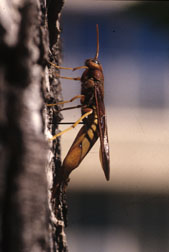 |
Figure 2. Pigeon tremex laying eggs. |
Only certain hardwood trees are attacked by pigeon tremex, notably silver maple, ash, cottonwood, and elm. (Several other species of horntails also occur in the state but these are limited to conifers, usually those growing in forested areas.) However, the insect may become locally abundant as these host trees become increasingly susceptible due to old age or disease. Because pigeon tremex is not considered to be a primary pest, controls have not been developed, although it likely can be temporarily managed by use of insecticides in a manner similar to that of other wood borers. (See Colorado State University Extension fact sheet 5.530, Shade Tree Borers.)
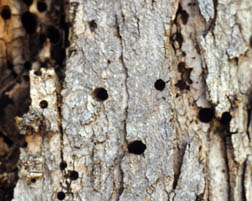 |
Figure 3. Round exit holes made by pigeon tremex. |
Adults of the pigeon tremex are active from June through early October. Females may be seen crawling over the bark and occasionally may insert their ovipositor into the trunk. (Dead females are sometimes seen stuck on the trunk with their ovipositor embedded in the tree.) If the conditions under the bark are suitable, notably a sufficiently low moisture content,
a few eggs (2 to 7) will be laid into the wood. Along with the eggs, the white rot fungus Daedalea unicolor is also introduced. This fungus grows within the wood ahead of the horntail larvae and is required for their successful development. Infection of trees with white rot fungus accelerates decay and further weakens the structure of affected trees. Larvae typically take nearly a year to become full-grown and then pupate just under the bark. The adult emerges in about a month after pupation and cuts a circular exit hole from which it leaves the tree.
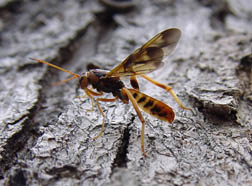 |
Figure 4. Ibalia anceps is another wasp that parasitizes the pigeon tremex(Photo by Mark MacMillan) |
Giant Ichneumon Wasp
The giant ichneumon wasp is a parasitic wasp (Hymenoptera: Ichneumonidae) specific to the pigeon tremex. It also is generally brown in color with yellow and orange markings. It has a very elongated body form and most notably long ‘tails’ that may extend a couple of inches. These ‘tails’ also are the ovipositor and supporting structures, used to insert eggs into wood onto developing pigeon tremex horntail laravae. Altogether the body and ovipositor of this insect may extend more than 5 inches. (Males are smaller, lack the ovipositor, and have a blunt tip of the abdomen.) Despite its rather fearsome appearance, the giant ichneumon wasp is harmless to humans and can not sting.
(The ovipositor of the female consists of three filaments. The central part is the actual ovipositor, capable of drilling through wood. Although appearing as a single filament, it is actually made of two parts, that interlock, slide against each other, and are tipped with the cutting edge. Although very thin, it is a tube and the egg moves down the minute channel
in its center during egg laying. The ovipositor is normally sheathed within two other thin filament structures that are protective in function, do not assist with drilling and bow out prominently around the insect during egg laying.)
The adult female can be seen searching the same areas used by the pigeon tremex, although they tend to be present a bit later in the summer. Developing horntail larvae can be detected under the bark by the female and she subsequently drills into the wood to the tunnel of the horntail larva. During egg laying (oviposition) the host larva is paralyzed with a sting after which the egg is laid. The parasitic wasp larva feeds on the paralyzed horntail larva, consuming it completely within a couple of weeks. It then pupates and remains dormant under the bark until the following summer, when the adults emerge.
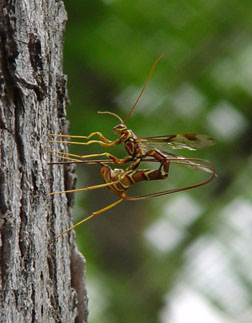 |
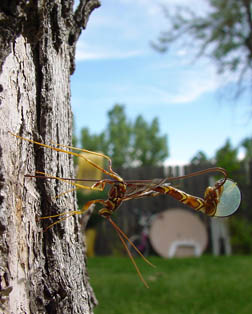 |
|
Figure 5. Giant ichneumon wasp
|
Figure 6. Giant ichneumon wasp
|
*W. Cranshaw Colorado State University Extension entomology specialist, and professor, bioagricultural sciences and pest management. 8/07. Revised 7/13.
Colorado State University, U.S. Department of Agriculture, and Colorado counties cooperating. CSU Extension programs are available to all without discrimination. No endorsement of products mentioned is intended nor is criticism implied of products not mentioned.
Go to top of this page.





